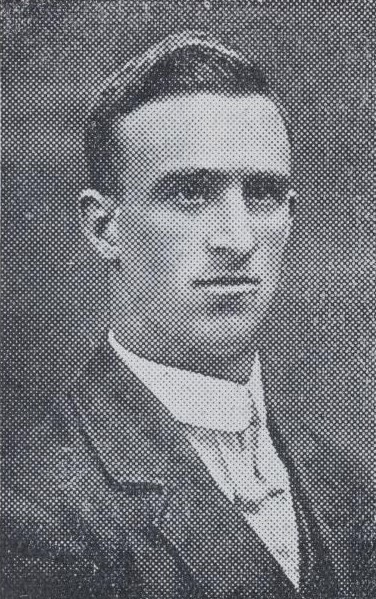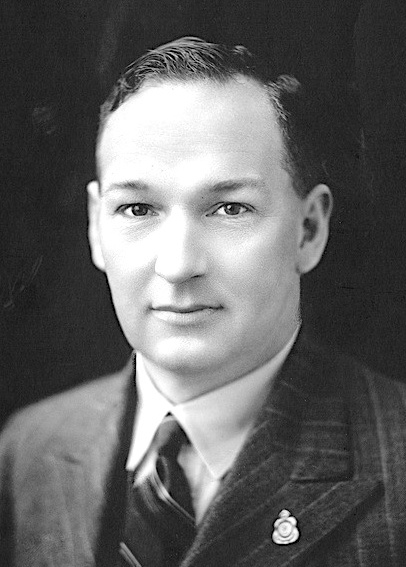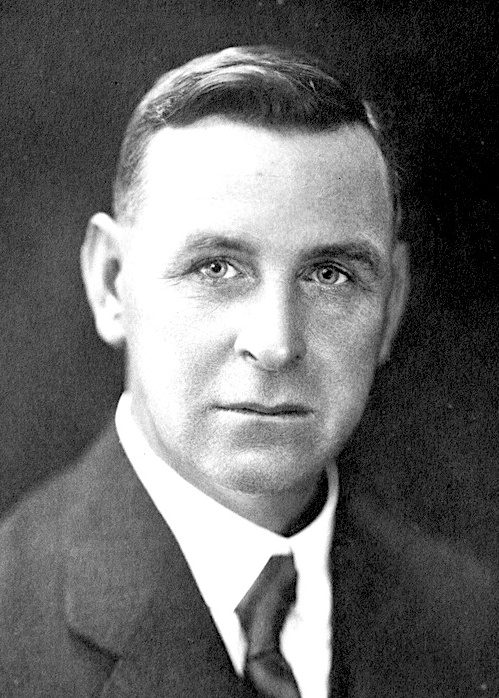|
Frank Staniford
Frank Clement Staniford (20 March 1893 – 25 August 1987) was an Australian politician. He represented the South Australian House of Assembly multi-member seat of Murray from 1924 to 1927 and 1930 to 1933 for the Labor Party. He was Chairman of Committees under Lionel Hill in his second term, and was Minister for Education, Minister for Immigration, Minister for Labour and Employment and Minister for Local Government in the short-lived Richards Ministry of 1933, following the 1932 Labor split. Staniford was born at Summertown and educated at Uraidla Public School after which he, like his father, became a fruitgrower. He served as secretary of the Labor Party branch in his teens and was secretary of the Summertown Institute and the Uraidla Hospital, president of the Uraidla Agricultural and Horticultural Society, president of the local agricultural bureau and secretary of the Mount Lofty Football Association. He was involved in the South Australian Fruitgrowers and Market Ga ... [...More Info...] [...Related Items...] OR: [Wikipedia] [Google] [Baidu] |
Frank Staniford
Frank Clement Staniford (20 March 1893 – 25 August 1987) was an Australian politician. He represented the South Australian House of Assembly multi-member seat of Murray from 1924 to 1927 and 1930 to 1933 for the Labor Party. He was Chairman of Committees under Lionel Hill in his second term, and was Minister for Education, Minister for Immigration, Minister for Labour and Employment and Minister for Local Government in the short-lived Richards Ministry of 1933, following the 1932 Labor split. Staniford was born at Summertown and educated at Uraidla Public School after which he, like his father, became a fruitgrower. He served as secretary of the Labor Party branch in his teens and was secretary of the Summertown Institute and the Uraidla Hospital, president of the Uraidla Agricultural and Horticultural Society, president of the local agricultural bureau and secretary of the Mount Lofty Football Association. He was involved in the South Australian Fruitgrowers and Market Ga ... [...More Info...] [...Related Items...] OR: [Wikipedia] [Google] [Baidu] |
Parliamentary Labor Party
The Parliamentary Labor Party (also known as the Premiers' Plan Labor Party or Ministerial Labor Party) was a political party active in South Australia from August 1931 until June 1934. The party came into existence as a result of intense dispute, especially within the Australian Labor Party, about the handling of the response to the Great Depression in Australia. In June 1931, a meeting of state premiers agreed on the Premiers' Plan, which involved sweeping austerity measures combined with increases in revenue. When the Premiers' Plan came up for a vote in South Australia, 23 of Labor's 30 House of Assembly members and two of Labor's four Legislative Council members voted for it. In August 1931, the South Australian state conference of the Labor Party expelled all of the MPs who supported the Premiers' Plan, including Premier Lionel Hill and his entire Cabinet. Expelled MPs (23) in the House of Assembly: * Frederick Birrell * Alfred Blackwell *Thomas Butterfield * Clement Col ... [...More Info...] [...Related Items...] OR: [Wikipedia] [Google] [Baidu] |
Members Of The South Australian House Of Assembly
This is a list of state elections in South Australia for the bicameral Parliament of South Australia, consisting of the House of Assembly ( lower house) and the Legislative Council (upper house). See also * List of South Australian House of Assembly by-elections * List of South Australian Legislative Council appointments * List of South Australian Legislative Council by-elections * Electoral districts of South Australia * Timeline of Australian elections External linksLower House results 1890-1965 Parliament of SA, www.parliament.sa.gov.au {{South Australian elections [...More Info...] [...Related Items...] OR: [Wikipedia] [Google] [Baidu] |
1987 Deaths
File:1987 Events Collage.png, From top left, clockwise: The MS Herald of Free Enterprise capsizes after leaving the Port of Zeebrugge in Belgium, killing 193; Northwest Airlines Flight 255 crashes after takeoff from Detroit Metropolitan Airport, killing everyone except a little girl; The King's Cross fire kills 31 people after a fire under an escalator Flashover, flashes-over; The MV Doña Paz sinks after colliding with an oil tanker, drowning almost 4,400 passengers and crew; Typhoon Nina (1987), Typhoon Nina strikes the Philippines; LOT Polish Airlines Flight 5055 crashes outside of Warsaw, taking the lives of all aboard; The USS Stark is USS Stark incident, struck by Iraq, Iraqi Exocet missiles in the Persian Gulf; President of the United States, U.S. President Ronald Reagan gives a famous Tear down this wall!, speech, demanding that Soviet Union, Soviet leader Mikhail Gorbachev tears down the Berlin Wall., 300x300px, thumb rect 0 0 200 200 Zeebrugge disaster rect 200 0 400 200 ... [...More Info...] [...Related Items...] OR: [Wikipedia] [Google] [Baidu] |
1893 Births
Events January–March * January 2 – Webb C. Ball introduces railroad chronometers, which become the general railroad timepiece standards in North America. * Mark Twain started writing Puddn'head Wilson. * January 6 – The Washington National Cathedral is chartered by Congress; the charter is signed by President Benjamin Harrison. * January 13 ** The Independent Labour Party of the United Kingdom has its first meeting. ** U.S. Marines from the ''USS Boston'' land in Honolulu, Hawaii, to prevent the queen from abrogating the Bayonet Constitution. * January 15 – The ''Telefon Hírmondó'' service starts with around 60 subscribers, in Budapest. * January 17 – Overthrow of the Kingdom of Hawaii: Lorrin A. Thurston and the Citizen's Committee of Public Safety in Hawaii, with the intervention of the United States Marine Corps, overthrow the government of Queen Liliuokalani. * January 21 ** The Cherry Sisters first perform in Marion, Iowa. ** The T ... [...More Info...] [...Related Items...] OR: [Wikipedia] [Google] [Baidu] |
George Bain Johnston
George Bain Johnston (28 November 1829 – 29 May 1882) was a pioneer of the Murray River trade in South Australia. History George Bain Johnston was born at Cockenzie, in the county of Haddington, Scotland, and was educated at Steel's Hospital in the parish of Tranent. At the age of 15 he served an apprenticeship on the schooner ''Mary Donaldson'', under Captain James Donaldson, in the employ of Captain Hew (or Hugh) Francis Cadell (c. 1790 – 27 April 1873). He was one of a group of Scotsmen who left Scotland in 1853 as one of the crew of the ''Lioness'', a small River Mersey steamer of 70 tons register, which was purchased by Cadell to be used for towing purposes in Port Melbourne. The vessel was rigged as a three-masted schooner in Scotland and sailed out to Melbourne. Other members of the crew of the ''Lioness'', all associated with the opening of the Murray, were James Ritchie, Thomas Johnston, John Barclay, John McDonald, William Barker and John Ritchie. The four first ... [...More Info...] [...Related Items...] OR: [Wikipedia] [Google] [Baidu] |
Murray River
The Murray River (in South Australia: River Murray) (Ngarrindjeri: ''Millewa'', Yorta Yorta: ''Tongala'') is a river in Southeastern Australia. It is Australia's longest river at extent. Its tributaries include five of the next six longest rivers of Australia (the Murrumbidgee, Darling, Lachlan, Warrego and Paroo Rivers). Together with that of the Murray, the catchments of these rivers form the Murray–Darling basin, which covers about one-seventh the area of Australia. It is widely considered Australia's most important irrigated region. The Murray rises in the Australian Alps, draining the western side of Australia's highest mountains, then meanders northwest across Australia's inland plains, forming the border between the states of New South Wales and Victoria as it flows into South Australia. From an east–west direction it turns south at Morgan for its final , reaching the eastern edge of Lake Alexandrina, which fluctuates in salinity. The water then flows throu ... [...More Info...] [...Related Items...] OR: [Wikipedia] [Google] [Baidu] |
Goolwa, South Australia
Goolwa is a historic river port on the Murray River near the Murray Mouth in South Australia, and joined by a bridge to Hindmarsh Island. The name "Goolwa" means "elbow" in Ngarrindjeri, the local Aboriginal language, and the area was known as "The Elbow" to the early settlers. Goolwa is approximately 85 km south of Adelaide, and is the seat of the Alexandrina Council. It is in the state electoral district of Hammond and the federal Division of Mayo. At the 2011 census, the state suburb of Goolwa (excluding Goolwa Beach, Goolwa North and Goolwa South) had a population of 2,201. At June 2018, the estimated urban population for Goolwa together with nearby Victor Harbor was 26,532, Estimated resident population, 30 June 2018. having increased at an average annual rate of 1.07% year-on-year over the preceding five years. The portion of this combined urban area residing in Goolwa is 11,578. History Before 1837 the area was briefly considered for the site of the colony's cap ... [...More Info...] [...Related Items...] OR: [Wikipedia] [Google] [Baidu] |
The Mount Barker Courier And Onkaparinga And Gumeracha Advertiser
''The Courier'' is a weekly newspaper published in Mount Barker, South Australia. For much of its existence its full title was ''The Mount Barker Courier and Onkaparinga and Gumeracha Advertiser'', later shortened to ''The Mount Barker Courier''. History The newspaper was founded as ''The Mount Barker Courier and Onkaparinga and Gumeracha Advertiser'' on 1 October 1880, price 3d. (3 pence) for 4 pages. Charles M. R. Dumas was sole proprietor, and its offices were on Gawler Street, Mount Barker. Publication continued every Friday morning. In 1893 tentative moves were made to introduce an alternative title ''Mount Barker Courier and Southern Advertiser'', but somehow the "less cumbrous title" never made it to the front page. The newspaper later absorbed another publication, printed by Lancelot Ramsay Thomson, the ''Mannum Mercury and Farmer's Journal'' (30 March 1912 - 2 March 1917). Dumas, who was for four years Member for Mount Barker, died on 19 February 1935, and his family ... [...More Info...] [...Related Items...] OR: [Wikipedia] [Google] [Baidu] |
1950 South Australian State Election
State elections were held in South Australia on 4 March 1950. All 39 seats in the South Australian House of Assembly were up for election. The incumbent Liberal and Country League led by Premier of South Australia Thomas Playford IV defeated the Australian Labor Party led by Leader of the Opposition Mick O'Halloran. Background Only one seat changed hands, rural Stanley saw the Labor member re-elected as an independent member. Notably, neither major party contested the independent-held seat of Ridley. Results * The primary vote figures were from contested seats, while the statewide two-party-preferred vote figures were estimated from all seats. Post-election pendulum See also * Results of the South Australian state election, 1950 (House of Assembly) * Candidates of the 1950 South Australian state election * Members of the South Australian House of Assembly, 1950-1953 * Members of the South Australian Legislative Council, 1950-1953 *Playmander Notes External links ... [...More Info...] [...Related Items...] OR: [Wikipedia] [Google] [Baidu] |
1947 South Australian State Election
State elections were held in South Australia on 8 March 1947. All 39 seats in the South Australian House of Assembly were up for election. The incumbent Liberal and Country League government led by Premier of South Australia Thomas Playford IV defeated the opposition Australian Labor Party led by Leader of the Opposition Robert Richards. Background The LCL won three seats—metropolitan Norwood, Prospect and Torrens—from Labor. The LCL won back rural Victoria after losing it to Labor at a by-election in 1945. Results * The primary vote figures were from contested seats, while the state-wide two-party-preferred vote figures were estimated from all seats. See also * Results of the South Australian state election, 1947 (House of Assembly) * Candidates of the 1947 South Australian state election * Members of the South Australian House of Assembly, 1947-1950 * Members of the South Australian Legislative Council, 1947-1950 *Playmander The Playmander was a gerrymanderi ... [...More Info...] [...Related Items...] OR: [Wikipedia] [Google] [Baidu] |
1938 South Australian State Election
State elections were held in South Australia on 19 March 1938. All 39 seats in the South Australian House of Assembly were up for election. The incumbent Liberal and Country League government led by Premier of South Australia Richard L. Butler defeated the opposition Australian Labor Party led by Leader of the Opposition Andrew Lacey. Background This election was the start of the electoral malapportionment which became known as the Playmander. It consisted of rural districts enjoying a 2-to-1 advantage in the state parliament, even though they contained less than half of the population, as well as a change from multi-member to single-member electorates, and the number of MPs in the lower house was reduced from 46 to 39. Labor remained out of power until the 1965 election. Tom Stott was one of 14 of 39 lower house MPs to be elected as an independent, which as a grouping won 40 percent of the primary vote, more than either of the major parties. Stott was the de facto leader of t ... [...More Info...] [...Related Items...] OR: [Wikipedia] [Google] [Baidu] |




.gif)
